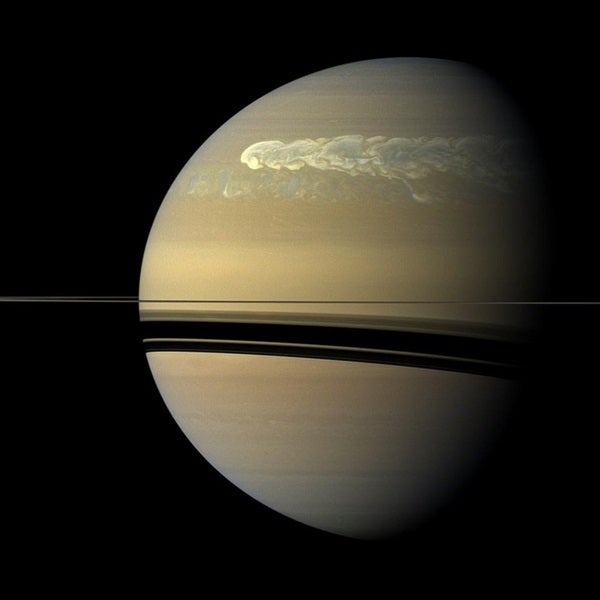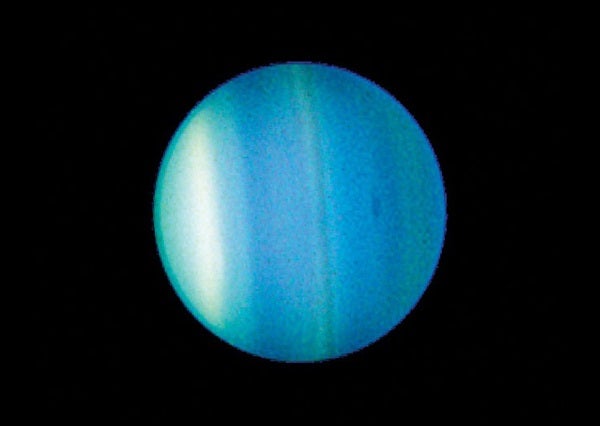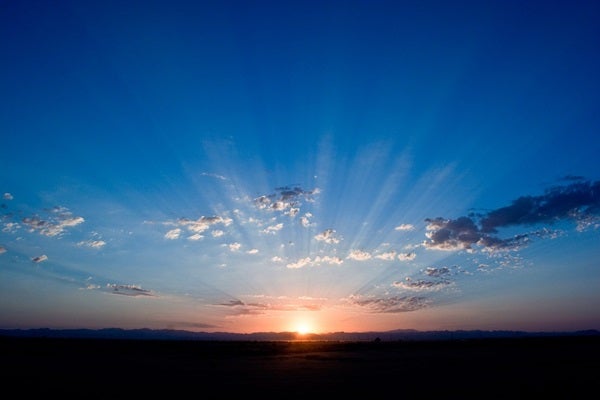Friday, June 3
• Saturn lies opposite the Sun in our sky today (officially at 3 a.m. EDT) and reaches its peak visibility for 2016. The ringed planet appears low in the southeast as darkness falls and grows more prominent as the evening wears on and it climbs higher. It stands about one-third of the way to the zenith in the southern sky around 1 a.m. local daylight time. Saturn lies among the background stars of southern Ophiuchus and shines at magnitude 0.0, nearly 10 times brighter than any of this constellation’s stars. When viewed through a telescope, the dramatic ring system spans 42″ and tilts 26° to our line of sight, while Saturn’s family of moderately bright moons appears next to the gorgeous world.
• The Moon reaches perigee, the closest point in its orbit around Earth, at 6:55 a.m. EDT. It then lies 224,402 miles (361,140 kilometers) away from us.
Saturday, June 4
• Another comet in the growing crowd of such objects discovered by the Pan-STARRS telescope in Hawaii makes its appearance in June’s morning sky. Comet PANSTARRS (C/2013 X1) currently glows around 7th magnitude in southern Aquarius. As a bonus today, the comet’s head lies less than 1° east of the Helix Nebula (NGC 7293) while the comet’s tail grazes this bright planetary. From most of the United States, you’ll need a haze-free southeastern horizon to spot the comet through a telescope shortly before dawn breaks.
• New Moon occurs at 11:00 p.m. EDT. At its new phase, the Moon crosses the sky with the Sun and so remains hidden in our star’s glare.
Sunday, June 5
• Mercury reaches greatest elongation today, when it lies 24° west of the Sun and stands 6° high in the east a half-hour before sunrise. The innermost planet shines at magnitude 0.5 and shows up easily through binoculars if you have an unobstructed horizon. When viewed through a telescope, Mercury appears 8″ across and about one-third lit.
Monday, June 6
• Mars remains near its peak all this week. The Red Planet reached opposition on May 22 and made its closest approach to Earth (at a distance of 46.8 million miles [75.3 million kilometers]) on the 30th. Mars appears low in the southeast as darkness falls and grows more prominent as the evening wears on and it climbs higher. By 11:30 p.m. local daylight time, it stands one-third of the way to the zenith in the southern sky against the backdrop of southeastern Libra. The world shines at magnitude –1.9, just a hair dimmer than the brightest point of light in the sky, Jupiter. When viewed through a telescope, Mars’ orange-red disk spans 18.5″. Look for subtle dark markings along with a whitish north polar cap.
• Venus passes behind the Sun from our perspective, a configuration astronomers call superior conjunction, at 6 p.m. EDT. (Our star actually occults the planet, an event that last occurred eight years ago.) Needless to say, the Sun’s glare makes it impossible to see Venus. The planet will return to view after sunset in late July.
Tuesday, June 7
• Observers of the outer solar system get their first good views of Uranus before dawn during June. The best time to look for it is shortly before twilight begins around 4 a.m. local daylight time. Uranus then lies low in the east among the background stars of Pisces the Fish. This morning, use binoculars to find the magnitude 5.9 planet 5° west of magnitude 4.3 Omicron (o) Piscium. A telescope reveals Uranus’ blue-green disk, which spans 3.4″.
Wednesday, June 8
• Brilliant Jupiter appears high in the southwest as darkness falls and remains on display until after 1 a.m. local daylight time. The giant planet shines at magnitude –2.0 — 0.1 magnitude brighter than Mars blazing in the southeast — against the backdrop of southern Leo the Lion. Jupiter appears equally dazzling through a telescope, which reveals a wealth of atmospheric detail on a disk that spans 36″. If you look carefully, you should notice its moon Callisto crossing the planet’s north polar regions. The transit begins at 11:02 p.m. EDT. About 90 minutes later, the satellite appears halfway across Jupiter’s disk.
Thursday, June 9
• The bright planets Mars and Saturn join with the 1st-magnitude star Antares to create a dramatic triangle in the southern sky these June evenings. A red supergiant star whose color mimics that of Mars, Antares is the luminary of the constellation Scorpius the Scorpion. Aim your binoculars a degree west (to the right) of the star and you’ll find the globular cluster M4. This object contains more than 100,000 stars and looks like a faint ball of cotton. A telescope shows dozens of stars scattered across the cluster’s face. To learn more about this constellation’s best telescopic objects, see “Target gems of Scorpius” in the June issue of Astronomy.
Friday, June 10
• Look high in the northwest after darkness falls this month, and you will see the familiar shape of the Big Dipper. The Dipper is the most conspicuous asterism — a recognizable pattern of stars that doesn’t embody a complete constellation shape — in the entire sky. It forms the body and tail of Ursa Major the Great Bear. Use the Pointers, the two stars at the end of the Dipper’s bowl, to find Polaris, which lies due north for everyone north of the equator. Polaris marks the end of the Little Dipper’s handle. On June evenings, the relatively faint stars of this dipper arc directly above Polaris.
Saturday, June 11
• A half-lit Moon hangs about 4° to Jupiter’s left in this evening’s sky. The pair becomes visible within a half-hour after sunset (though the Moon shows up in the daytime sky during the afternoon) and remains on view until 1 a.m. local daylight time. The Moon officially hits First Quarter phase at 4:10 a.m. EDT tomorrow morning.
Sunday, June 12
• For people who live near 35° north latitude, today marks the earliest sunrise of the year. Although the Northern Hemisphere’s longest day doesn’t occur until Earth’s summer solstice on June 20, earliest sunrise happens several days before and latest sunset several days after. The specific dates depend on your latitude, however. In general, earliest sunrise occurs closer to the solstice the farther north you live.












